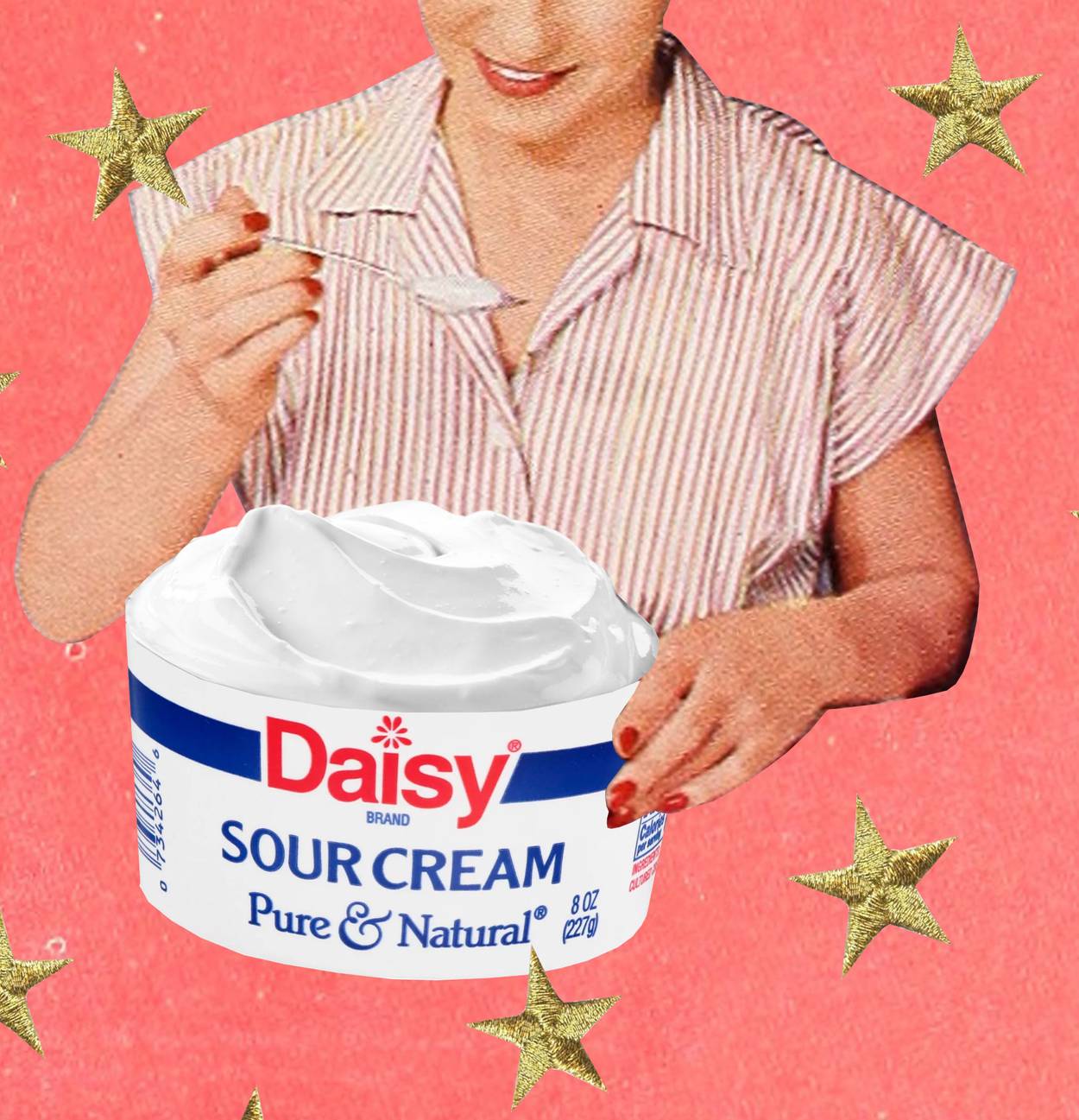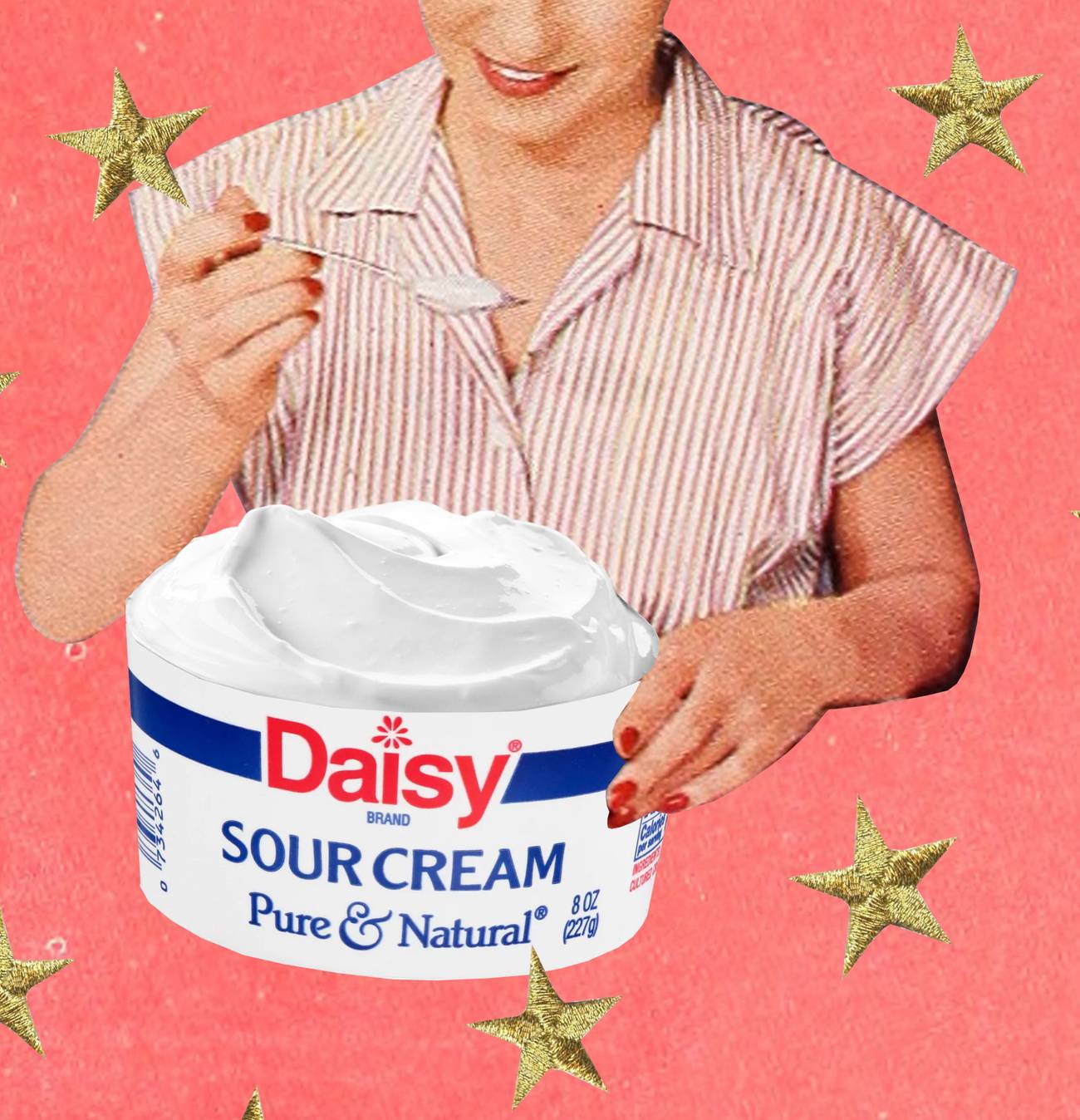The Joy of Sour Cream
Even if you generally avoid it to for dieting reasons, indulge in this Jewish staple on Shavuot




In my childhood home, sour cream almost constituted a food group. We spooned it over potatoes, blintzes, latkes, borscht, pierogies, yellow squash, string beans, mamaliga, strawberries, blueberries, and banana slices—the last having been immortalized in the spoof song “Have a Banana,” sung to the tune of “Hava Nagila.” (The final lyrics are “pass the sour cream.”) And we ate it with egg noodles, my personal favorite, the cream melting to create a slightly tangy, instant, mock Alfredo sauce.
My earliest memory of sour cream is of eating it sprinkled with white sugar and served alongside a scoop of cottage cheese—a quickie kiddie supper that served the same role frozen pizza would play for my brood three decades later.
It wasn’t just my family. In those pre-hummus, pre-tahini, and pre-sriracha days, sour cream was everywhere: in supermarkets, in specialized Jewish dairy shops like Daitch’s (the ancestor of the Food Emporium), on starched tablecloths at Grossingers (the now-defunct paradisiacal Catskill Mountains resort), and at New York’s beloved and also long-gone Jewish dairy eateries such as Ratner’s, Steinberg’s, Famous, and Farm Food, where it was served in dainty white ceramic bowls. At those restaurants, one could order a dish called Farmer’s, or Jewish, Chop Suey, a non-politically correct name for a mix of sour cream, cottage cheese, and fresh vegetables.
My family never ordered Jewish Chop Suey—it seemed pointless to go out to eat something you could easily make at home. What we did order and enjoy was krupnik, the porridgelike mushroom and barley soup served with sour cream, its creamy tang complementing the meatiness of the mushrooms.
Jews clearly have a thing for sour cream. But is it Jewish food? What better time to ask than Shavuot?
According to the website Ten Random Facts, the beloved white condiment derives from the Mongolian alcoholic drink “kumis,” originally made from the milk of female horses. How kumis morphed into sour cream is unclear. What is known is that by the 19th century, sour cream—smetana in Russian and Yiddish, or tejfol in Hungarian—had become Ashkenazi Jewry’s favorite cultured milk product.
Why? Not just because it tastes so good.
Like the other “sauers”—sauerkraut and sour pickles—sour cream was born out of necessity, writes the late food historian Gil Marks. Before refrigeration, fermentation was employed to increase the shelf life of fragile foods like milk. In the shtetl, many Jews owned cows and milk was in ample supply.
Shtetl Jews didn’t eat much meat—generally not on weekdays and, if times were especially tough, possibly not even on Shabbat. Sour cream provided a cheap source of protein along with vitamins A and D, as well as calcium and protein, and it added a zippy flavor to a potato-heavy diet and could be easily made at home.
Until the 1920s, and in some places until many decades later, milk wasn’t homogenized. Without emulsification, the cream naturally rose to the top. All one needed to do was to separate it and leave it at room temperature overnight to grow the natural lactobacilli that would cause it to grow thick and tangy. That bacteria also aided indigestion. Today’s sour cream is leaner—most commercial sour cream contains between 18% and 20% fat. (In Israel, sour cream comes in three varieties: 9%, 15%, and a 27% fat variation called shamenet shel paam, or old-fashioned sour cream—its packaging illustrated with a wistful image of a red-roofed cottage and a tree.) Unfortunately the pasteurization process that reduces the risk of food poisoning also murders those healthy gut-enhancing live bacteria.
So, is today’s sour cream healthy? Yes and no.
Eaten together with veggies (think Farmer’s Chop Suey), sour cream will flatten hunger and aid in the absorption of fat-soluble vitamins such as A, D, E, and K, which are important in preventing diabetes and cancer. But beware: Half of sour cream’s calories come from saturated fat, which increases the LDL (bad) cholesterol that leads to heart disease.
So enjoy sour cream, but in moderation. Don’t turn it into a food group.
As Shavuot draws close, dairy cases in Israel and in kosher groceries throughout the Jewish world overflow with the stuff along with numerous other cheeses and dairy derivatives. Although it’s customary to eat dairy foods on Hanukkah to recall Judith’s bravery, Shavuot—the late spring holiday, which celebrates the giving of the Torah—is the Jewish calendar’s best-known dairy celebration.
Why dairy? Because the Torah is compared to milk. Just as milk or cream or sour cream nourishes the body, so, too, does the Torah nourish the soul.
In gematria, the ancient wisdom system extracts hidden meaning from Hebrew words by ascertaining the numerical value of the letters in a word. The letters in halav, the Hebrew word for milk, add up to 40: the number of days Moses spent on Mount Sinai receiving the Torah.
In the Psalms, Mount Sinai is referred to as tohar gavnunim, a mountain of majestic peaks—but it can also be read as a cheese mountain (gevina is the Hebrew word for cheese).
Because it’s stored in earthenware or these days in cartons or plastic rather than silver or golden vessels, milk and all milk derivatives symbolize humility. The Torah is also preserved in humble vessels meaning the humble folk who study it and share its teachings.
It feels like more than a coincidence that my mother, a lifelong sour cream lover and cheese lover, was born just one day after Shavuot.
During her final year, after she’d had become rail thin and wheelchair-bound, I hired a private chef to cook for her. Dementia had robbed her of her ability to read and communicate; eating was one of her few remaining pleasures. As nonagenarians are absolved from concerns with weight gain and elevated cholesterol, my instructions were simple: “Put sour cream on everything.”
My mother thrived, even gaining a bit of badly needed weight, and I was thrilled—but then the chef quit. A few months later, my mother developed pneumonia, which would eventually kill her. Was that because of excess phlegm produced by all that sour cream? I have no way of knowing and I sincerely hope not.
I don’t eat much sour cream anymore. It’s not because of my mother. These days my diet is informed by weight and cholesterol consciousness as well as environmental concerns. I’m a weekday vegan. Sometimes I mix cashew butter with lemon juice and brewer’s yeast to create an ersatz nondairy sour cream. It’s not bad. But it’s not the real thing.
I’m Orthodox in my Judaism but not in my veganism. On Shavuot, I’ll bake my cheesecake with cream cheese (not the Tofutti kind) and full-fat sour cream. I hope I’ll limit my consumption to one small slice but I’ll probably have more. And if some sour cream is left over after the holiday, I’ll stir it into steaming egg noodles. Healthy for the body? In moderation, not so bad for the body—and wonderful for the soul.
Carol Ungar’s writing has appeared in Next Avenue, Forbes, NPR, the Jerusalem Post Magazine, and Fox News. She also leads memoir writing workshops on Zoom.